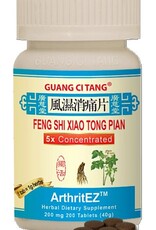EZJoint (Feng Shi Xiao Tong Pian)
| Availability: | In stock (1) |
| Available in store: | Check availability |
What does it do?
In the joints, cartilage normally protects the joints, absorbs shock from movement and allows the joints to move smoothly. Cartilage may wear away as a result of aging, overuse, or even autoimmune diseases such as rheumatoid arthritis (RA). Without the normal amount of cartilage, bones may rub together and cause pain, swelling, and stiffness in the joint area.
According to Traditional Chinese Medicine (TCM), these joint complaints are referred as "Bi Zheng" or painful obstruction syndrome, which can be caused and/or aggravated by Wind, Cold, Damp or Heat. Pain of any sort may also be caused or aggravated by Blood stagnation. Feng Shi Xiao Tong Pian is a warming formula best used in cases of Wind-Cold-Damp type painful obstruction syndrome (Bi Syndrome) which is further complicated by Blood stagnation. This herbal formula disperses Wind, Cold and Damp, moves the Blood, and strengthens the sinews and bones. Possible applications include joint stiffness, lower back soreness or stiffness, sensation of cold in the joints, difficulty walking, weakness of the legs, swelling of the joints resulting from blood stasis due to trauma such as a fall.
Feng Shi Xiao Tong Pian is composed of a number of herbs which work together to dispel Wind, Cold and Damp, and strengthen the tendons and bones.
Hai Feng Teng (Kadsura stem) dispels Wind-Damp for painful obstruction syndrome (Bi Zheng). Mo Yao (Myrrh) and Ru Xiang (Boswellia) are used together to activate Blood, relieve pain and relax the tendons. This pair of herbs is combined here with Niu Xi (Achyranthes) and Dang Gui (Chinese Angelica root) to strengthen their effect. Niu Xi tonifies the Kidneys and Liver, strengthens tendons and bones. Dang Gui has the ability to both invigorate and tonify the Blood. Dang Gui is often paired with Gui Zhi (Cinnamon twigs) and Bai Shao (White Peony root) for sensation of cold in the extremities. Bai Shao nourishes the Blood, softens the Liver and relieves numbness and spasms. Gui Zhi is an important guiding herb here used to warm and open the channels as well as disperse Wind-Cold. Mu Gua (Papaya) relaxes the sinews, opens the channels, and relieves spasms and stiffness especially when used in combination with Ru Xiang, Mo Yao, Dang Gui and Bai Shao as it is here.
Gui Zhi, Mo Yao and Ru Xiang are best for joints when combined with Qiang Huo (Notopterygium root) and Du Huo (Pubescent Angelica root). Qiang Huo and Du Huo both release the exterior, dispel Cold, eliminate Dampness and alleviate pain. Fang Feng (Siler) is also added to further dispel Wind, Cold and Damp and release the exterior. Qian Nian Jian (Homalomena) dispels Wind and Damp too, but also strengthens the tendons and bones and is good at supporting the joints, particularly when used in combination with Du Huo and Niu Xi as it is here.
Du Zhong (Eucommia bark) is a Yang tonic used to tonify both the Liver and Kidneys, strengthen tendons and bones and support the back and joint functions. Yan Hu Suo (Corydalis) activates Qi and Blood circulation to relieve pain. Jiang Huang (Turmeric) also activates Blood circulation, opens the channels, reduces swelling. Chi Shao (Red Peony root) modestly clears heat and dispels Blood stasis. A slight degree of heat clearing is useful to balance the effects of the other herbs which are mostly warm in nature. Gan Cao (Licorice root) harmonizes the formula.
Does research support EzJoint?
Several herbs are shown in studies to support healthy inflammation response such as Myrrh and Boswellia1, Achyranthes1, Chinese Angelica3, and Turmeric4.
Ingredients
What is the formula composition?
A proprietary blend of
Kadsura pepper vine
(Piper kadsura)
(Hai Feng Teng)
Myrrh resin
(Commiphora myrrha)
(Mo Yao)
Flowering quince fruit
(Chaenomeles speciosa)
(Mu Gua)
Siler root
(Saposhnikovia divaricata)
(Fang Feng)
Cassia twig
(Cinnamomum cassia)
(Gui Zhi)
Chinese licorice root
(Glycyrrhiza uralensis)
(Gan Cao)
Notopterygium rhizome and root
(Notopterygium incisum)
(Qiang Huo)
Frankincense resin
(Boswellia carterii)
(Ru Xiang)
Achyranthes root
(Achyranthes bidentata)
(Niu Xi)
Eucommia bark
(Eucommia ulmoides)
(Du Zhong)
Pubescent angelica root
(Angelica pubescens)
(Du Huo)
Corydalis yanhusuo rhizome
(Corydalis yanhusuo)
(Yan Hu Suo)
Turmeric rhizome
(Curcuma longa)
(Jiang Huang)
Dong quai root
(Angelica sinensis)
(Dang Gui)
Chinese peony root with bark
(Paeonia lactiflora)
(Chi Shao)
Chinese peony root
(Paeonia lactiflora)
(Bai Shao)
Homalomena rhizome
(Homalomena occulta)
(Qian Nian Jian)


